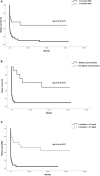Anti-glomerular Basement Membrane Glomerulonephritis: A Study in Real Life
- PMID: 35865174
- PMCID: PMC9295717
- DOI: 10.3389/fmed.2022.889185
Anti-glomerular Basement Membrane Glomerulonephritis: A Study in Real Life
Abstract
Introduction: Anti-glomerular basement membrane (anti-GBM) disease is a severe entity with few therapeutic options including plasma exchange and immunosuppressive agents. The aim of this study was to analyze the clinical and pathological features that predict the evolution of end-stage kidney disease (ESKD) and the kidney survival in a cohort of patients with anti-GBM disease with renal involvement in real life.
Methods: A retrospective multicentre observational study including 72 patients from 18 nephrology departments with biopsy-proven anti-GBM disease from 1999 to 2019 was performed. Progression to ESKD in relation to clinical and histological variables was evaluated.
Results: Creatinine at admission was 8.6 (± 4) mg/dL and 61 patients (84.7%) required dialysis. Sixty-five patients (90.3%) underwent plasma exchange. Twenty-two patients (30.6%) presented pulmonary hemorrhage. Kidney survival was worse in patients with creatinine levels > 4.7 mg/dL (3 vs. 44% p < 0.01) and in patients with > 50% crescents (6 vs. 49%; p = 0.03). Dialysis dependence at admission and creatinine levels > 4.7 mg/dL remained independent significant predictors of ESKD in the multivariable analysis [HR (hazard ratio) 3.13 (1.25-7.84); HR 3 (1.01-9.14); p < 0.01]. The discrimination value for a creatinine level > 4.7 mg/dL and 50.5% crescents had an area under the curve (AUC) of 0.9 (95% CI 0.82-0.97; p < 0.001) and 0.77 (95% CI 0.56-0.98; p = 0.008), respectively. Kidney survival at 1 and 2 years was 13.5 and 11%, respectively. Patient survival at 5 years was 81%.
Conclusion: In real life, patients with severe anti-GBM disease (creatinine > 4.7 mg/dL and > 50% crescents) remained with devastating renal prognosis despite plasma exchange and immunosuppressive treatment. New therapies for the treatment of this rare renal disease are urgently needed.
Keywords: anti-glomerular basement membrane disease; crescents; end-stage kidney disease (ESKD); glomerulonephritis (GN); kidney survival; plasma exchange.
Copyright © 2022 Sánchez-Agesta, Rabasco, Soler, Shabaka, Canllavi, Fernández, Cazorla, López-Rubio, Romera, Barroso, Huerta, Calle, Sierra, Domínguez-Torres, Moreno-Ramírez, Afonso, Mascarós, Coca, Espinosa and Spanish Group for the Study of Glomerular Diseases (GLOSEN).
Conflict of interest statement
The authors declare that the research was conducted in the absence of any commercial or financial relationships that could be construed as a potential conflict of interest.
Figures




References
-
- McAdoo SP, Tanna A, Hrušková Z, Holm L, Weiner M, Arulkumaran N, et al. Patients double-seropositive for ANCA and anti-GBM antibodies have varied renal survival, frequency of relapse, and outcomes compared to single-seropositive patients. Kidney Int. (2017) 92:693–702. 10.1016/j.kint.2017.03.014 - DOI - PMC - PubMed

